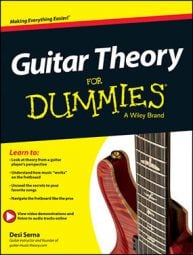Guitar theory reveals that the major scale is stacked in thirds to make triads and chords. Each scale degree of the major scale produces a triad and major or minor chord. Starting with the first degree of the major scale, the chord qualities go as follows:
major-minor-minor-major-major-minor-minorb5 (also called a diminished triad)
This seven-chord sequence is one of the most important patterns in music. When it comes to playing chord progressions, musicians refer to this pattern by using uppercase Roman numerals to represent major chords and lowercase Roman numerals to represent minor chords.
The following chart will help you keep track of the system:
Uppercase Roman numerals: I-II-III-IV-V-VI-VII
Lowercase Roman numerals: i-ii-iii-iv-v-vi-vii
Here's what this naming system looks like in action when you apply it to the major scale chord sequence and the key of G, specifically:
Major Scale
I-ii-iii-IV-V-vi-viib5
G Major Scale
G-Am-Bm-C-D-Em-F#mb5
![[Credit: Illustration courtesy of Desi Serna]](https://www.dummies.com/wp-content/uploads/389500.image0.jpg)
Credit: Illustration courtesy of Desi Serna

